英乐博客
学习英语,欣赏音乐。
|
Scarborough Fair Artist: Simon and Garfunkel Are you going to Scarborough Fair Parsley, sage, rosemary and thyme Remember me to one who lives there She once was a true love of mine Tell her to make me a cambric shirt (On the side of a hill in the deep forest green) Parsley, sage, rosemary and thyme (Tracing of sparrow on snowcrested brown) Without no seams nor needle work (Blankets and bedclothes the child of the mountain) Then she'll be a true love of mine (Sleeps unaware of the clarion call) Tell her to find me an acre of land (On the side of a hill a sprinkling of leaves) Parsley, sage, rosemary and thyme (Washes the grave with silvery tears) Between the salt water and the sea strands (A soldier cleans and polishes a gun) Then she'll be a true love of mine Tell her to reap it with a sickle of leather (War bellows blazing in scarlet battalions) Parsley, sage, rosemary and thyme (Generals order their soldiers to kill) And gather it all in a bunch of heather (And to fight for a cause they've long ago forgotten) Then she'll be a true love of mine Are you going to Scarborough Fair Parsley, sage, rosemary and thyme Remember me to one who lives there She once was a true love of mine |
Scarborough Fair The fair In the early 17th century competition from other towns' markets and fairs and increasing taxation saw further collapse of the Fair until it eventually became financially untenable. The market was revived again in the 18th century, but due to intense competition Scarborough Fair finally ended in 1788. The traditional 'Scarborough Fair' no longer exists but a number of low-key celebrations take place every September to mark the original event. Scarborough Fair in July 2006 witnessed Medieval Jousting Competitions, hosted by English Heritage in addition to the usual attractions.
As the versions of the ballad known under the title "Scarborough Fair" are usually limited to the exchange of these impossible tasks, many suggestions concerning the plot have been proposed, including the hypothesis that it is a song about the Plague. In fact, "Scarborough Fair" appears to derive from an older (and now obscure) Scottish ballad, The Elfin Knight (Child Ballad #2),[1] which has been traced at least as far back as 1670 and may well be earlier. In this ballad, an elf threatens to abduct a young woman to be his lover unless she can perform an impossible task ("For thou must shape a sark to me / Without any cut or heme, quoth he"); she responds with a list of tasks that he must first perform ("I have an aiker of good ley-land / Which lyeth low by yon sea-strand"). However these lyrics appear to be more attributable to Anglo-Saxon than Scots. As the song spread, it was adapted, modified, and rewritten to the point that dozens of versions existed by the end of the 18th century, although only a few are typically sung nowadays. The references to "Scarborough Fair" and the refrain "parsley, sage, rosemary and thyme" date to nineteenth century versions, and the refrain may have been borrowed from the ballad Riddles Wisely Expounded, (Child Ballad #1), which has a similar plot. Meaning of the refrain Sober and grave grows merry in time
The arrangement made famous by Simon & Garfunkel's "Scarborough Fair/Canticle" originated in the late 20th century. Paul Simon learned it in 1965 in London from Martin Carthy. Then Art Garfunkel set it in counterpoint with "Canticle", a reworking of Simon's 1963 song "The Side of a Hill" with new, anti-war lyrics. It was the lead track of the 1966 album Parsley, Sage, Rosemary and Thyme, and was released as a single after being featured on the soundtrack to The Graduate in 1968. The copyright credited only Simon and Garfunkel as the authors, causing ill-feeling on the part of Carthy, who felt the "traditional" source should have been credited. This rift remained until Simon invited Carthy to duet the song with him at a London concert in 2000. Prior to Simon's learning the song, Bob Dylan had borrowed the melody and several lines from Carthy's arrangement in creating his song, "Girl from the North Country," which appeared on The Freewheelin' Bob Dylan (1963), Nashville Skyline (1969) (together with Johnny Cash), Real Live (1984) and The 30th Anniversary Concert Celebration (1993). |






